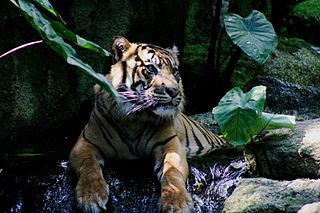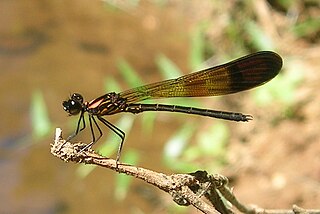
The fauna of Indonesia is characterised by high levels of biodiversity and endemicity due to its distribution over a vast tropical archipelago. Indonesia divides into two ecological regions; western Indonesia which is more influenced by Asian fauna, and the east which is more influenced by Australasian species.

The lovely fairywren, or lovely wren, is a species of bird in the Australasian wren family, Maluridae. It is endemic to northeastern Australia. Its natural habitats are subtropical or tropical dry forest and subtropical or tropical moist lowland forest.

Graphium mendana is a species of butterfly in the family Papilionidae, that is found in Papua New Guinea and the Solomon Islands.

Elattoneura is a genus of damselflies in the family Platycnemididae.

Chlorocyphidae is a family of damselflies, commonly known as jewels. These are colorful species native to the Old World tropics, where they occur along forest streams. They are most diverse in Southeast Asia.
Lophichthys boschmai, also known as Arafura frogfish or Boschma's frogfish, is a species of Anglerfishes closely related to frogfish. L. boschmai is the only species in the Lophichthydae family. L. boschmai were first reported by Marinus Boseman in 1964 to the Rijksmuseum van Natuurlijke Historie, now known as National Museum of Natural History in Leiden. The species was named after Dutch zoologist, Hildbrand Boschma.

Adolph Cornelis 'Dolf' van Bruggen was a Dutch malacologist, entomologist, and botanist. His interest in the tropics and tropical Africa has dominated his broad scientific interest for more than 50 years now. He was an expert especially in the land snail families Streptaxidae, Achatinidae and Maizaniidae. As of 2008, he had authored some 655 scientific publications.

Hepalastis pumilio is a moth of the family Pterophoridae. It has worldwide tropical distribution, including Argentina, Brazil, Colombia, Costa Rica, Cuba, Ecuador, Guadeloupe, Jamaica, Mexico, Puerto Rico, Suriname, Japan, Micronesia, South Africa the Virgin Islands as well as Queensland and New Guinea.
Cherax holthuisi is a species of crayfish from the Bird's Head Peninsula in New Guinea. It grows to a total length of 81–93 mm (3.2–3.7 in) and is typically pink, orange or yellow in wild specimens. It was described in 2006 after animals circulating in the aquarium trade could not be assigned to any known species.
Agyrtacantha is a genus of dragonflies in the family Aeshnidae. Species of Agyrtacantha can be large, dull-coloured dragonflies.

Diphlebia euphoeoides, sometimes spelled Diphlebia euphaeoides, known as the tropical rockmaster is an Australian species of broad winged damselfly. It is one of a group known as the azure damselflies. It is found in Queensland (Australia) and Papua New Guinea. It typically occurs near lakes, waterfalls or streams at relatively low altitudes, and is occasionally seen near dry pools.
Mordellistenoda is a genus of beetles in the family Mordellidae, containing the following species:
Cheroscorpaena tridactyla, the Humpback waspfish, is a species of wasp scorpionfish found only in the Gulf of Papua where it is an inhabitant of coral reefs. This species grows to a length of 15 centimetres (5.9 in) TL. This species is the only known member of its genus.

Calicnemia is a genus of damselflies in the family Platycnemididae. There are over 20 species distributed in Southeast Asia, China, India, and Pakistan.

Coeliccia is a genus of damselflies in the family Platycnemididae. They are distributed in Asia from India to Japan to Indonesia. It is the largest genus in the family, with over 60 species.

Copera is a genus of damselflies in the family Platycnemididae. They are distributed in Asia, especially Southeast Asia.
Cyanocnemis is a monotypic genus of damselflies in the family Platycnemididae containing the single species Cyanocnemis aureofrons. This species is endemic to Indonesia, where it is known only from the 1939 type collections made in what is now the province of Papua on the island of New Guinea.

Austroagrion is a genus of damselflies belonging to the family Coenagrionidae. Species of Austroagrion are small dragonflies; males are black with blue or green markings while females are paler. Austroagrion occurs in Papua New Guinea, New Caledonia and Australia.














